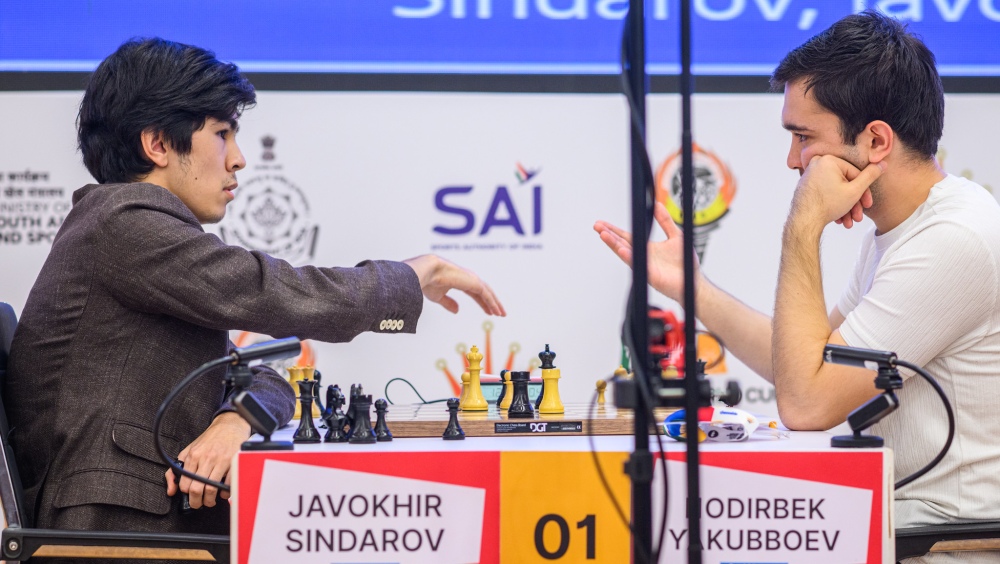From Pawns to Queens: A new Chess in Schools Initiative

The Singapore Chess Federation “SCF” is delighted to announce our latest project, “From Pawns to Queens”, a chess in schools initiative in collaboration with Greenwood Primary School. This project aims to trial a large-scale beginner chess programme to promote chess learning among the school’s Primary 1 and Primary 2 students, with the longer term goal to make chess a regular feature in the school’s programmes at all levels, and use chess learning to teach essential cognitive and life skills. The idea of the name “From Pawns to Queens” stemmed from the literal meaning of teaching our young students how to move all the pieces. Beyond mastering the game, our mission is to inspire children to embrace the concepts of empowerment, growth, and development—both on and off the board. Just as pawns have the potential to become queens through strategic effort and perseverance, we encourage kids to realise their own potential, develop confidence, and grow into empowered individuals. The project started with a chess camp that took place on the 4th and 5th of November. Each day began with a mass briefing in the school hall, with Woman FIDE Master Dijana Dengler explaining the origin of chess and the absolute basics to 455 Primary 1 and 2 (aged 7 and 8) students. Dijana, a councilor in FIDE’s Chess in Education Commission and a chess teacher at Overseas Family School is highly experienced and skilled at teaching the basics of chess to young children. Her entertaining presentation, with the help of FT Philipp Ziegler, also from Overseas Family School, captivated the audiences who eagerly engaged with her whenever questions were posed. Dijana Dengler and Philipp Ziegler from Overseas Family School provided engaging teaching sessions to the Greenwood Primary kids After 45 minutes, the group returned to their respective classrooms for a more in-depth learning experience. The SCF team, together with 16 volunteers from the chess community, then spent the next 2 hours continuing the teaching process, and allowing the children to experience playing chess against each other for the first time. The feedback from the school was highly positive. Many of the kids expressed joy at learning the game and wished to learn more after the training camp. SCF hopes to continue our collaboration with Greenwood Primary School in bringing more chess to its students. The Singapore Chess Community came together to launch this programme The SCF is heartened that the Singapore Chess Community has stepped forward to support this programme. We sincerely thank the following partners: Greenwood Primary School Team Principal: Mrs. Tricilia Chua Vice-Principal: Mr. Tan Kar Wee Year Head/Lower Primary: Mrs. Sharon Teo Assistant Year Head/Lower Primary: Mdm Celeste Teo Chess Academies and teachers Ms Elisha Paciencia, Ms Ericka Paciencia, Mr Aziz Abdul from Chess Grande Mr. Osric Mooi WIM Anjela Khegay FM Dino Ballecer from Chess Whizdom Mr. Arlan Cabe from Chess Castle Pte Ltd Mr. Jedidiah Huang from The Jedi Chess Academy Chess enthusiasts Ms Vanessa Mcconville, Ms Dijana Dengler and Mr. Philipp Ziegler from Overseas Family School Mr. Peter Dengler from London Stock Exchange Group Students Mr. Andrew Tan, Ms. Eden Pang, Ms. Audelle Sim, Mr. Joash Chan and Ms. Dayana Chin For more information regarding From Pawns to Queens and other SCF social initiatives, please contact socialprojects@singaporechess.org.sg
FIDE Team crowned World Champions in Linares

Azerbaijan’s historic silver and China’s resilient bronze cap a thrilling Women’s World Team Championship. The 2025 Women’s World Team Championship concluded in Linares with a showcase of elite competition, rising talent, and historic performances. Team FIDE claimed the world title with an undefeated run, Azerbaijan secured a landmark silver, and China completed the podium with a well-earned bronze. Exceptional individual results across all six boards highlighted the global depth of the women’s game, from Ulviyya Fataliyeva’s commanding board-one gold to Polina Shuvalova’s sensational 9.5/10 and 2827 rating performance on board three. Final standings The closing ceremony brought a festive end to an intense and unforgettable week of competition. Winners’ trophies, gold, silver, and bronze medals, along with a selection of commemorative gifts, were presented by Auxi del Olmo, Mayor of Linares; Javier Ochoa, President of the Spanish Chess Federation; and Victor Bologan, FIDE Executive Director. 🏆 1st place – Gold Medal: FIDE Team With undefeated match play and standout individual performances, the FIDE squad claimed the championship title in commanding style. 🥈 2nd place – Silver Medal: Azerbaijan A remarkable run, full of grit and inspired tiebreak victories, earned Azerbaijan a well-deserved second place. 🥉 3rd place – Bronze Medal: China Led by GM Hou Yifan and supported by a rising generation of talents, China secured the final podium spot after two narrow wins in the bronze-medal duel. Individual board medals Three individual medals – gold, silver, and bronze – were also awarded at the prize-giving ceremony by Martin De La Torre, Concejal de Juventud y Deportes. The prizes were determined by rating performance, with eligibility requiring a minimum of five classical games played during the event. Board/place Player Country Performance Games Points 1st board 🥇 Fataliyeva, Ulviyya AZE 2524 10 6 🥈 Hou, Yifan CHN 2523 6 3½ 🥉 Padmini, Rout IND 2495 7 4 2nd board 🥇 Kamalidenova, Meruert KAZ 2531 9 6 🥈 Javakhishvili, Lela GEO 2492 6 4 🥉 Song, Yuxin CHN 2488 10 6 3rd board 🥇 Shuvalova, Polina FIDE 2827 10 9.5 🥈 Khotenashvili, Bella GEO 2456 6 4 🥉 Lu, Miaoyi CHN 2376 10 5 4th board 🥇 Arabidze, Meri GEO 2463 7 5 🥈 Garifullina, Leya FIDE 2407 8 5½ 🥉 Savitha Shri B IND 2401 7 4 5th board 🥇 Shukhman, Anna FIDE 2675 5 4½ 🥈 Zhai, Mo CHN 2391 8 4½ 🥉 Nurgaliyeva, Zarina KAZ 2276 5 2 6th board 🥇 Kaliakhmet, Elnaz KAZ 2515 9 7 Let’s take a closer look at how the afternoon unfolded. Luis Rentero Lechuga, son of Luis Rentero Suarez, driving force behind the classic Linares tournaments, opened the final round with the gong ceremony. Team FIDE dominated Azerbaijan in the final with an impressive 5.5–2.5 overall score. Throughout the championship, the squad remained undefeated, conceding very few individual games. While every team member delivered consistently strong performances, the backbone of their success came from the lower boards: Polina Shuvalova (gold on board three), Leya Garifullina (silver on board four), and Anna Shukhman (gold on board five), all of whom were in exceptional form. The first match ended 3–1 for FIDE, with two wins and two draws. On board three, IM Polina Shuvalova (2473) continued her remarkable run, securing the board gold medal with an extraordinary 9.5/10, one of the finest individual results of the event. On board one, GM Aleksandra Goryachkina (2540) once again demonstrated her world-class technique, gradually outplaying IM Ulviyya Fataliyeva (2420) in a long and demanding queen endgame. Queen endings are notoriously treacherous: perpetual check motifs lurk everywhere, and even a pawn advantage offers no guarantee of victory. Fataliyeva had already defended with admirable resilience for seventy-four moves, but exhausted after a long tournament and a gruelling game, she missed the drawing resource 74…Qf7! Another good option was 74…Qa8+, maintaining the balance. Instead, Ulviyya chose the wrong check 74…Qa5+?, a move that ultimately loses after 75.Kf6 Qa7+ 76.Qd7! Qa3+ 77.Kf6! The g-pawn, and the game, could not be saved. It was a heart-breaking defeat for Ulviyya Fataliyeva, though her gold medal on board one remains a remarkable achievement and undoubtedly one she will treasure throughout her career. The second match closed the event with a 2.5–1.5 victory for FIDE, featuring three draws, though GM Kateryna Lagno (2517) escaped one difficult moment, and a clean, confident win by IM Leya Garifullina (2458) that sealed the championship title. https://youtu.be/9p5lFNPFe8g In the battle for bronze, China prevailed over Kazakhstan with a narrow but deserved 5–3 overall score, delivered through two hard-fought 2.5–1.5 victories. Led by GM Hou Yifan (2620), who guided a youthful line-up with her trademark calm authority, China secured an excellent third place along with a handful of individual distinctions. The Chinese squad earned two silver medals: one for the former four-time Women’s World Champion on board one, and another for WGM Zhai Mo (2384) on board five. They added two bronze medals as well, thanks to strong performances from IM Song Yuxin (2448) on board two and rising star IM Lu Miaoyi (2440) on board three. Kazakhstan’s campaign, meanwhile, was undoubtedly hampered by the absence of their top player, GM Bibisara Assaubayeva (2513), during the semi-finals. According to the team captain, Assaubayeva had fallen ill. She returned for the first game of today’s match, playing White on board one against IM Song Yuxin, who stepped in for Hou Yifan, but was defeated and understandably chose to rest again for the second encounter. Even so, the Kazakh team did not leave empty-handed. They claimed three individual medals: gold for IM Meruert Kamalidenova (pictured above, center) on board two, gold for WIM Elnaz Kaliakhmet (2274) on board six, and bronze for WIM Zarina Nurgaliyeva (2310) on board five. Despite narrowly missing out on a place in the final, the experience gained, especially for their young talents, will surely prove invaluable in the years ahead. Written by IM
FIDE World Cup: Sindarov and Wei Yi advance to final after dramatic tiebreaks

It was the quickest day at the FIDE World Cup so far, with both semifinal tiebreak matches ending in the first 15+10 rapid portion. The day concluded by 16:45, but the speed did not diminish the drama. In the match between Javokhir Sindarov and Nodirbek Yakubboev, Sindarov’s preparation paid off as he took the first rapid game converting a winning endgame. The second game was more tense, with Yakubboev finding real chances to strike back, but the players eventually drew, sending Sindarov through as the first player to reach the finals as well as the 2026 FIDE Candidates. On the opposite side of the stage, the match between Andrey Esipenko and Wei Yi was a rollercoaster from beginning to end. Wei Yi, considered the favourite, obtained winning chances as Black in the first game but ultimately drew. In the second rapid game, it was Esipenko who held the advantage until a fateful rook blunder reversed the outcome and cost him the match. It was a shocking end to the semifinal tiebreaks. The ceremonial first move was made by Mr. Sadanand Shet Tanavade, Member of Parliament (Rajya Sabha), on the board between Sindarov and Yakubboev. Throughout the event, it has been encouraging to see the interest shown by government officials and the AICF’s efforts to invite distinguished guests to each game. At 15:00, the silence of the hall shifted to the quick tapping of clocks. Unlike the classical games, all players seemed settled from the very first moves, confidently blitzing out their opening choices. Here is a closer look at how the games unfolded: Semifinals tiebreak results: Andrey Esipenko ½–1½ Wei YiJavokhir Sindarov 1½–½ Nodirbek Yakubboev Javokhir Sindarov (2721) vs Nodirbek Yakubboev (2689) Javokhir Sindarov is only a few rating points away from becoming the top player in Uzbekistan. As The Guardian recently described, he is “on the verge” of the world elite, and he demonstrated that level today by starting the semifinal tiebreaks with a win over Nodirbek Yakubboev with the Black pieces. The first game began in a typical Semi-Slav structure, following a sideline known for its solidity. Both players appeared well prepared, but they soon diverged from known theory. Up to that point they had played accurately, but White, already behind on time throughout the game, made several imprecise decisions that allowed Black to take over. In a closed position with both sides holding two rooks, White with a bishop, and Black with a knight, Sindarov used the flexibility of his knight to maneuver it into strong squares on the queenside. This eventually forced the bishop-knight exchange, leaving Black with a superior pawn structure. In the resulting position, Black controlled the board with active rooks pressing against White’s isolated e-pawn. With less than a minute remaining, Yakubboev was forced to defend resourcefully. Sindarov did not find an immediate finishing blow, but he eventually secured two connected passed pawns on the queenside. With no realistic defensive chances left, Yakubboev resigned, placing himself in a must-win situation with Black in the second rapid game. Their second 15+10 game began in a Sicilian Najdorf and quickly turned chaotic after White launched an early kingside pawn storm. A key psychological moment came when Sindarov spent nine minutes on 12.f4. Our studio commentators, Grandmasters Peter Leko and Jan Gustafsson, pointed out that this may have caused Yakubboev to relax slightly and choose the wrong plan. White gained an advantage, and Black soon had to give up the exchange, relying on the bishop pair to create counterplay. As is often the case in this time control, chances swung back and forth. Sindarov lost his advantage for a moment, and suddenly Black stood better with real hope of staying in the event. But a major mistake changed the evaluation again. Although White did not convert perfectly and allowed equality more than once, he eventually steered the game into a draw. Here, Black should ignore the potential discovered check on the d-file and play something like 26…Bg2, followed by 27.Bxe3+ Kc6 28.Rh2 Bf3. The position remains equal but requires accuracy from White. Instead, Yakubboev played 26…Kc8?, moving the king away from danger but shutting off his rook and giving White a +3 advantage. Sindarov was not fully precise in converting, exchanging winning chances for equality several times, but a final liquidation to a draw was enough to secure his place in the finals and the 2026 FIDE Candidates. Sindarov was delighted after the match, though he expressed sadness for his teammate, noting that Yakubboev had played well. In our interview, he spoke proudly about his performance today and shared that his family, including his brother, had traveled to Goa to support him, bringing Uzbek food and sweets to lift his spirits. It seems to be working. Andrey Esipenko (2693) vs Wei Yi (2752) Wei Yi looked markedly different after winning the tiebreak against Andrey Esipenko today, especially given the stroke of luck that helped him not just survive the second game but win it. First, let’s revisit the opening rapid game, where the Chinese grandmaster once again started strongly, echoing his match against Arjun Erigaisi, where he recovered from a difficult classical phase with much stronger play in the tiebreaks. With the Black pieces, the game repeated yesterday’s Petroff Defense with the lesser-played 7.Be4, but this time Wei Yi had improved preparation and adopted a slightly different move order, confidently emerging with a better position. In the final stage of the game, a crucial moment appeared: Both players were low on time, and this last move by White was inaccurate. Black had the strong 33…Bd6, forcing the bishops off the board due to the threat of …c5, leading to a centralised king after 34.Bxd6 Kxd6 and real winning chances. Instead, Wei opted for 33…Bf4, and after 34.Re2 Be5, the players repeated moves and drew the game. A steady Italian Game started their second rapid encounter. For a long time, the position seemed dry, with no clear attacking prospects and a stable 0.0 evaluation. Then White

